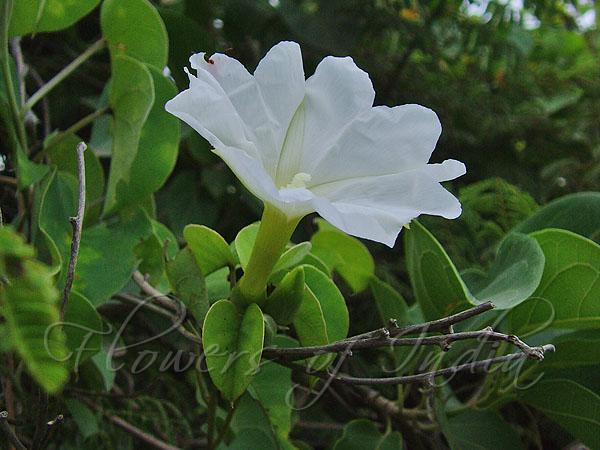|
| Midnapore Creeper |
|

|

| File size | 83251 |
| Original date | 8/2/08 6:37 PM |
| Resolution | 600 x 450 |
| Flash | Flash did not fire, auto, red-eye reduction |
| Focal length | 6.6mm |
| Exposure time | 1/125s |
| Aperture | 3.5 |
| Focus Distance | |
| Metering Mode | Spot |
| Camera make | Samsung Techwin |
| Camera model | |
| Sensor type | OneChipColorArea |
|
|
|
|
Photo: |
Botanical name: Rivea hypocrateriformis Family: Convolvulaceae (Morning glory family)
Synonyms: Convolvulus hypoleucus, Rivea fragrans, Rivea ornata
Synonyms: Convolvulus hypoleucus, Rivea fragrans, Rivea ornata
Midnapore Creeper is a robust woody climbing shrub,
found in dry subtropical forests of India and Pakistan. Flowers are
creamy white, typical morning glory form, flat-faced, 6-9 cm long.
Flowers usually solitary, occasionally subspicate. Sepals unequal,
ovate, blunt apically, 10-12 mm long, densely short villose. Leaves are
rounded-heart-shaped, blunt apically, densely appressed velvet-hairy
below. Fruit indehiscent or tardily dehiscent, dry-baccate, 2 cm long.
Seeds brown, hairless.
Leaves boiled in water, then added to bajra (millet) or jowar flour
which is made into bread. Leaves are also boiled together with
condiments, i.e. prepared into bhaji. Rajasthan: young shoots and
leaves eaten as vegetable.
Medicinal uses: One of the main uses of this
plant in Ayurvedic medicine is as a contraceptive. When taken in the
very early stages, it can prevent implantation of the foetus and is
known to completely interrupt early pregnancy and influence the estrous
cycle. The plant is also reported for its ethnomedicinal uses in
treating cough, headache, skin disease, malaria etc, as well as
treating external conditions such as burns, piles and to relieve pain.
One of the main uses of this
plant in Ayurvedic medicine is as a contraceptive. When taken in the
very early stages, it can prevent implantation of the foetus and is
known to completely interrupt early pregnancy and influence the estrous
cycle. The plant is also reported for its ethnomedicinal uses in
treating cough, headache, skin disease, malaria etc, as well as
treating external conditions such as burns, piles and to relieve pain.
Medicinal uses:
 One of the main uses of this
plant in Ayurvedic medicine is as a contraceptive. When taken in the
very early stages, it can prevent implantation of the foetus and is
known to completely interrupt early pregnancy and influence the estrous
cycle. The plant is also reported for its ethnomedicinal uses in
treating cough, headache, skin disease, malaria etc, as well as
treating external conditions such as burns, piles and to relieve pain.
One of the main uses of this
plant in Ayurvedic medicine is as a contraceptive. When taken in the
very early stages, it can prevent implantation of the foetus and is
known to completely interrupt early pregnancy and influence the estrous
cycle. The plant is also reported for its ethnomedicinal uses in
treating cough, headache, skin disease, malaria etc, as well as
treating external conditions such as burns, piles and to relieve pain.
| Identification credit: Satish Phadke | Photographed in Maharashtra. |
• Is this flower misidentified? If yes,